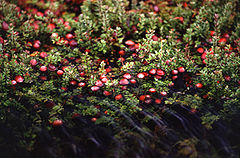**Botanical Information**:
– **Species**:
– Vaccinium erythrocarpum
– Vaccinium japonicum
– Vaccinium macrocarpon
– Vaccinium microcarpum
– Vaccinium oxycoccos
– **Distribution**:
– Cultivated in northern United States, Canada, and Chile
– Found in acidic bogs in cooler regions of Northern Hemisphere
– Native to Northern North America, Canada, and Eastern United States
– Native to Southeastern United States at high altitudes in the Southern Appalachian Mountains
**Cultivation and Propagation**:
– **Cultivation**:
– Constructed in upland areas with shallow water table
– Topsoil scraped off to form dykes, sand spread, beds laser leveled flat
– Irrigation equipment installed for vine growth and frost protection
– **Propagation**:
– Vines propagated by moving from established bed
– Spread on sand surface in new bed, frequent watering until roots form
– Light nitrogen fertilizer applied during first year, renovation costs $30,000 to $50,000 per acre
**Harvesting and Production**:
– **Ripening and Harvest**:
– Harvested in fall after first frost, beds flooded with water
– Cleaned, sorted, stored; dry-picked less bruised, sold as fresh fruit
– Fresh market cranberries stored without mechanical refrigeration
– **Production**:
– Top producers in 2020: United States, Canada, and Chile
– Wisconsin and Quebec largest regional producers in North America
– World production in 2020 was 663,345 tonnes
**Medical and Research**:
– **Medical Use**:
– Prevent UTIs, effective in reducing UTI risk in certain groups
– Limited evidence of effect in other groups, continued research ongoing
– Potential safety concerns with juice and supplements
– **Research**:
– Rich in polyphenols, ongoing studies on cardiovascular, immune system, cancer effects
– Limited human study confirmation on polyphenol benefits, research on tooth decay and plaque formation ongoing
**Economic and Marketing**:
– **Marketing and Economics**:
– U.S. cranberry sales peak during Thanksgiving and Christmas
– Ocean Spray cooperative dominates North American market
– Market fluctuations due to oversupply and changing consumer preferences
– **International Trade**:
– EU largest importer of American cranberries, major importers include Canada, China, Mexico, South Korea
– U.S. cranberry exports play significant role in agricultural economy, promoted internationally for market expansion.
Cranberries are a group of evergreen dwarf shrubs or trailing vines in the subgenus Oxycoccus of the genus Vaccinium. In Britain, cranberry may refer to the native species Vaccinium oxycoccos, while in North America, cranberry may refer to Vaccinium macrocarpon. Vaccinium oxycoccos is cultivated in central and northern Europe, while Vaccinium macrocarpon is cultivated throughout the northern United States, Canada and Chile. In some methods of classification, Oxycoccus is regarded as a genus in its own right. Cranberries can be found in acidic bogs throughout the cooler regions of the Northern Hemisphere.
| Cranberries | |
|---|---|

| |
| Cranberry bush with fruit partially submerged | |
| Scientific classification | |
| Kingdom: | Plantae |
| Clade: | Tracheophytes |
| Clade: | Angiosperms |
| Clade: | Eudicots |
| Clade: | Asterids |
| Order: | Ericales |
| Family: | Ericaceae |
| Genus: | Vaccinium |
| Subgenus: | Vaccinium subg. Oxycoccus (Hill) A.Gray |
| Species | |
|
Vaccinium erythrocarpum | |



Cranberries are low, creeping shrubs or vines up to 2 meters (7 ft) long and 5 to 20 centimeters (2 to 8 in) in height; they have slender, wiry stems that are not thickly woody and have small evergreen leaves. The flowers are dark pink, with very distinct reflexed petals, leaving the style and stamens fully exposed and pointing forward. They are pollinated by bees. The fruit is a berry that is larger than the leaves of the plant; it is initially light green, turning red when ripe. It is edible, but with an acidic taste that usually overwhelms its sweetness.
In 2020, the United States, Canada, and Chile accounted for 97% of the world production of cranberries. Most cranberries are processed into products such as juice, sauce, jam, and sweetened dried cranberries, with the remainder sold fresh to consumers. Cranberry sauce is a traditional accompaniment to turkey at Christmas and Thanksgiving dinners in the United States and Canada, and at Christmas dinner in the United Kingdom.
